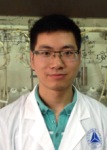Org. Synth. 2016, 93, 29-36
DOI: 10.15227/orgsyn.093.0029
Synthesis of 5-(Hydroxymethyl)furfural (HMF)
Submitted by Svilen P. Simeonov, Jaime A. S. Coelho, and Carlos A. M. Afonso
*1
Checked by Mengyang Fan and Dawei Ma
1. Procedure
5-(Hydroxymethyl)furfural (2). A 500-mL single-necked, round-bottomed flask equipped with a 3.5-cm ellipsoidal magnetic stir bar is charged with
tetraethylammonium bromide (45 g, 214 mmol) (
Note 1), distilled water (5 mL) and
fructose (
1) (10 g, 0.056 mol) (
Note 2). The flask is placed in an oil bath at 100 °C. The reaction temperature is monitored by a thermometer placed inside the reaction mixture. When the internal temperature reaches 90 °C (
Note 3),
Amberlyst® 15 (1 g, 10%w/w) (
Note 4) is added. The stirring is continued for 15 min, during which time the internal temperature reaches 96-98 °C and the color of the reaction mixture turns brown (
Note 5). After this period the flask is removed from the heat source and the solution separated from the
Amberlyst® 15 by decantation of the hot solution into a 2-L single-necked round-bottomed flask (
Note 6). Absolute
ethanol (20-30 mL) is used to wash the catalyst after the transfer, and the
ethanol is added to the aqueous solution. The reaction mixture is placed on a rotary evaporator for 1 h (15 mmHg, 50 °C) (
Note 7). A 3.5-cm ellipsoidal magnetic stir bar is added, and the residue is dissolved in hot absolute anhydrous
ethanol (25 mL), which is followed by immediate addition of
ethyl acetate (1.5 L) under vigorous stirring. Immediate precipitation of the
tetraethylammonium bromide is observed, and the mixture is cooled down to room temperature. The precipitate is vacuum-filtered through a fritted filter and the cake rinsed with
ethyl acetate (100 mL) (
Note 8). The collected filtrate is vacuum-filtered through a pad of silica gel (30 g) using a fritted filter, and the silica gel is rinsed with
ethyl acetate (100 mL) (Notes
9 and
10). The filtrate is concentrated by rotary evaporation (32 °C, 15 mmHg). The oily residue is transferred into a 50 mL single-necked round-bottomed flask and the residual organic solvent is removed
in vacuo (0.5 mmHg). The title compound is obtained as deeply orange liquid (5.8-6.1 g, 83-87%) and 90-92% purity (
Note 11). Flash column
chromatography (
Note 12) was applied to give the title compound as an orange liquid (5.5 g, 79%) with 97% purity (Notes
13,
14 and
15).
Figure 1. Reaction Assembly
2. Notes
1.
Tetraethylammonium bromide (
TEAB) (98%) was purchased from Alfa-Aesar and used directly. The submitter used
tetraethylammonium bromide (98%) purchased from Sigma Aldrich.
2.
Fructose (>99%) was purchased from TCI and used directly. The submitter used
fructose (100%) that was obtained from a supermarket.
3. The temperature is reached within 15-20 min. The submitter reports that the reaction mixture became homogeneous at this point, but the checkers observed insoluble particles in the solution.
4.
Amberlyst® 15 hydrogen form wet was purchased from Sigma Aldrich and used as received (~48% moisture according to product specification). An old batch (apparently dried) afforded less pure isolated
HMF (80%).
5. The reaction temperature should not exceed 98-100 °C, because this can result in formation of impurities.
6. If the catalyst is not removed, formation of impurities in the final product is observed. The
tetraethylammonium bromide may precipitate from the solution during cooling, which may make filtering of the solution difficult. Consequently, it is recommended that the solution remains hot during the decantation.
7. The water should be completely removed, because the presence of water can inhibit precipitation in the subsequent operation.
8. The collected
tetraethylammonium bromide (
TEAB) precipitate is dried using high vacuum rotary pump for 3 h to give 44 g of
TEAB as a pale yellow powder. New
TEAB (1 g) is added to provide 45 g. The procedure can be repeated using this source of
TEAB to provide
HMF (6.1 g) as a deep orange liquid with purity of 80%. The submitters report that the purity of the second run can reach 97%.
9. This step is required in order to remove any traces of dissolved
TEAB.
10. 230-400 mesh SiliaFlash
® P60 (Silicycle Inc.) was used.
11. The submitters report that the deeply orange liquid would solidify in a freezer at -12 °C, but the checkers found the impure product would not solidify completely. Only a semisolid was obtained.
12. The inner diameter of the column is 8 cm and 320 g (700 mL) silica gel (Note 10) was used. The eluent was comprised of hexane/EtOAc, ranging from 3/1 (300 mL/100 mL) to 2/1 (600 mL/300 mL). TLC on silica gel 60 F254 plate (EtOAc:Hexane, 1:1), product R
f = 0.4.
13.
5-(Hydroxymethyl)furfural is known to be light and temperature unstable. It should be kept in a freezer for long term storage. No observable degradation occurred when stored in a freezer for up to 8 months.
14. TLC on silica gel 60 F254 plate (EtOAc:Hexane, 1:1) R
f = 0.4.
1H NMR
pdf(400 MHz, CDCl
3) δ: 2.60 (br s, 1H), 4.71 (s, 2H), 6.51 (d,
J = 3.6 Hz, 1H), 7.21 (d,
J = 3.6 Hz, 1H), 9.58 (s, 1H);
13C NMR
pdf(100 MHz, CDCl
3) δ: 57.1, 110.0, 123.8, 152.0, 161.2, 177.9. IR (liquid film, cm
-1): 3465 (O-H), 3121, 2929, 2840, 1690 (C=O), 1528 (C=C), 1398, 1280, 1194, 1016. The product was obtained as an orange liquid that solidifies in a freezer at -12 °C. Due to the low mp, it was not possible for the submitters to determine the mp.
15. The purity of the product was determined by HPLC. The analyses were performed on Dionex Ultimate 3000RS, detection at 220 nm, Kinetex, 2.6 μ, XB-C18, 100 x 4.6mm. R
t (
HMF) = 1.01 min. Mobile phase gradient from 10:90 to 100:0 for 5 min acetonitrile:water, flow 1.8 mL/min. The purity of
HMF was determined by comparing the obtained integration area of
HMF with other observed minor peaks. The obtained values were in the range of 85-92% from the different reactions before further purification. After flash column chromatography, the purity reached 97%.
Working with Hazardous Chemicals
The procedures in
Organic Syntheses are intended for use only by persons with proper training in experimental organic chemistry. All hazardous materials should be handled using the standard procedures for work with chemicals described in references such as "Prudent Practices in the Laboratory" (The National Academies Press, Washington, D.C., 2011; the full text can be accessed free of charge at
http://www.nap.edu/catalog.php?record_id=12654). All chemical waste should be disposed of in accordance with local regulations. For general guidelines for the management of chemical waste, see Chapter 8 of Prudent Practices.
In some articles in Organic Syntheses, chemical-specific hazards are highlighted in red "Caution Notes" within a procedure. It is important to recognize that the absence of a caution note does not imply that no significant hazards are associated with the chemicals involved in that procedure. Prior to performing a reaction, a thorough risk assessment should be carried out that includes a review of the potential hazards associated with each chemical and experimental operation on the scale that is planned for the procedure. Guidelines for carrying out a risk assessment and for analyzing the hazards associated with chemicals can be found in Chapter 4 of Prudent Practices.
The procedures described in Organic Syntheses are provided as published and are conducted at one's own risk. Organic Syntheses, Inc., its Editors, and its Board of Directors do not warrant or guarantee the safety of individuals using these procedures and hereby disclaim any liability for any injuries or damages claimed to have resulted from or related in any way to the procedures herein.
3. Discussion
During the recent years
5-(hydroxymethyl)furfural (
HMF) collected considerable interest from the researchers worldwide as a very important chemical building block derived from biorenewable resources.
2 Under investigations are broad range of
HMF conversions to useful chemicals for the industry such as polymer industry,
3 pharmacy,
4 fuel chemistry.
5,6,7 Derived from
HMF Furan-2.5-dicarboxylic acid is described as one of the building blocks of the future.
85-(Hydroxymethyl)furfural (
HMF) is synthesized by dehydration of carbohydrates under acid catalysis and
fructose is the best starting material for its lab scale synthesis. Because of the low solubility of
fructose in organic solvents the dehydration is typically performed in water, ionic liquids, DMSO, eutectic mixtures or biphasic systems.
9,10 Although high yields up to 100% are reported in some cases the purification of
HMF remains challenging.
HMF is not easy to extract from aqueous phase, since the distribution coefficient between the organic and the aqueous phase is not favorable. Polar organic solvents such as DMSO and DMF have high boiling points but
HMF is not stable at high temperatures and the distillation is undesirable.
The procedure described herein is originated on our previous communication
11 and is based on simple precipitation of the reaction media (
tetraethyl ammonium bromide) allowing complete separation of
HMF in high yields and purity in a single step without extraction or column chromatography. Although
HMF is known to be unstable, no formation of side products or decomposition was observed during the work up procedure and it was isolated with above 95% purity by HPLC and can be directly used in further reactions or if required stored in the freezer.
Appendix
Chemical Abstracts Nomenclature (Registry Number)
Tetraethylammonium bromide (71-91-0)
Fructose (1) (57-48-7)
Amberlyst 15 (39389-20-3)
5-(Hydroxymethyl)furfural (HMF) (2) (67-47-0)

|
Svilen P. Simeonov was born in 1980 in Ruse (Bulgaria). He graduated from Sofia University in 2004 and joined the Institute of Organic Chemistry with Centre of Phytochemistry, Bulgarian Academy of sciences as a Research Fellow. In 2010 he moved to University of Lisbon and received his PhD in 2014 under the supervision of Prof. Carlos A. M. Afonso. After, he returned back to Sofia and is currently working as a Researcher at the the Institute of Organic Chemistry with Centre of Phytochemistry, Bulgarian Academy of Sciences. His research interested are mainly focused on green chemistry methodologies, flow chemistry, valorisation of natural resources and asymmetric catalysis. |

|
Jaime A. S. Coelho was born in 1986 in Lisbon, Portugal. He received his B.Sc and M.Sc degrees in Chemistry from Instituto Superior Técnico, Portugal. He then moved to Faculty of Pharmacy, University of Lisbon, where he completed a Ph.D. (2014) under the supervision of Prof. Carlos A. M. Afonso. During his doctoral studies he also joined Prof. Nuno Maulide group at Max-Planck-Institut für Kohlenforschung, Mülheim an der Ruhr, Germany, for six months. After a one year postdoctoral experience at Faculty of Pharmacy, University of Lisbon, Portugal, he joined Prof. Dean Toste group, University of California, Berkeley, where he is a visiting researcher. His research interests include catalysis, development of new methodologies and valorization of natural resources. |

|
Carlos A. M. Afonso (born in 1962) is currently Full Professor at Faculty of Pharmacy, University of Lisbon. He received his Ph.D. in 1990 under the supervision of Professor Christopher Maycock, subsequently became Assistant Professor at New University of Lisbon and Associate Professor at the Instituto Superior Técnico in Lisbon (2004-2010), and took a postdoctoral fellow (1990) at the Imperial College of Science Technology and Medicine (W. B. Motherwell) and sabbatical leave (1997/1998) at University of Bath, UK (Jonathan Williams) and at the University of Toronto (Robert Batey). His main interests are new catalyzed synthetic methodologies, green chemistry (reactions in water, ionic liquids, PEG, solvent free, catalyst reuse, membrane technology), synthetic valorization of national natural resources, development of new materials (ionic liquids, probes), and biotransformations. |

|
Mengyang Fan was born in 1989 in Xuzhou, China. He obtained his B.Sc. degree from the Department of Chemistry and Chemical Engineering, Southeast University in 2011. He then joined the Ph.D. program in the laboratory of Professor Dawei Ma at Shanghai Institute of Organic Chemistry and is studying transition metal catalyzed C-H bond activation. |
Copyright © 1921-, Organic Syntheses, Inc. All Rights Reserved